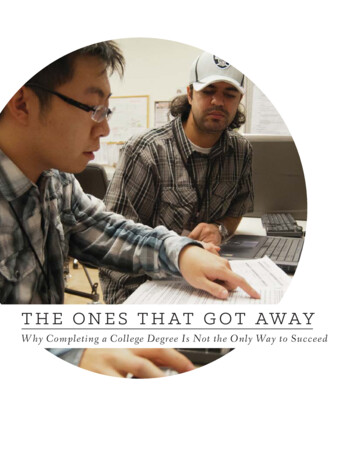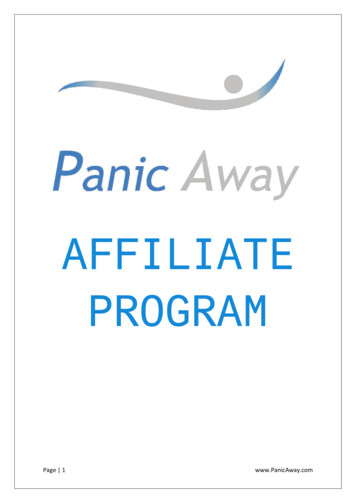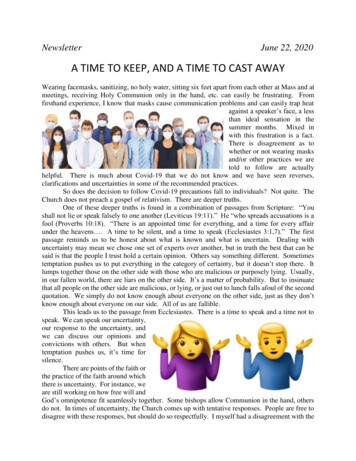
Transcription
T H E O N E S T H A T G O T AWAYWhy Completing a College Degree Is Not the Only Way to Succeed
Acknowled gement sThis LearningWorks inquiry guide was prepared in association with WestEd, a research, development, andservice agency that works with education and other communities to promote excellence, achieve equity, andimprove learning for children, youth, and adults.The principal author of this guide was Kathy Booth, Senior Research Associate at WestEd. It follows on threeprevious pieces published by LearningWorks: The Missing Piece: Quantifying Non-Completion Pathwaysto Success (2013), What’s Completion Got to Do With It? Using Course-Taking Behavior to UnderstandCommunity College Success (2012), and Segmentation Model of Assisting Course-Taking Patterns: A ResearchMethodology and Discussion Guide (2012).See the “Find Out More” section at the end of this guide for a listing of related guides and resources on the topicof skills-builder students.A boutLEARNINGWORKSLearningWorks aims to strengthen student achievement in community colleges. It does so byfacilitating, disseminating, and funding practitioner-informed recommendations for changesat the system and classroom levels, infusing these strategies with state and national insights.LearningWorks is supported by the William and Flora Hewlett Foundation and the Walter S.Johnson Foundation.WESTEDWestEd is a nonprofit research, development, and service agency that works with educationand other communities to promote excellence, achieve equity, and improve learning forchildren, youth, and adults. WestEd has served as the West’s Regional Educational Laboratoryfor over 40 years. To learn more about WestEd’s areas of work, the services we offer, and theimpact our agency has had on policies, systems, and people of all ages, visit WestEd.org.2SEP TEMBER 201 4
design LIZ MAYORGAphotography ELI ZANTURANSKIDAN FIGUEROA3
Int r oduc t ionRecent research on the California community college system has revealed thatworkforce training programs yield some of the highest earnings for communitycollege students, regardless of whether those students complete a degree or collegecertificate. Still, most conversations about community college success are limitedto whether students graduate. An exclusive focus on degree completion does notfit well with the diversity of workforce training pathways that colleges have builtin career and technical education (CTE), because many of these pathways do notlead to a college credential. By expanding definitions of student success to includeemployment, earnings gains, and third-party credentials, colleges will be able tomore accurately measure the outcomes of all their CTE programs. This brief drawson numerous studies to explore alternative approaches to measuring how wellcommunity colleges serve CTE students.4
UNDERSTA NDING CTE PATH WAYSResearch SourcesCommunity colleges offer many different careertraining pathways to serve a wide variety of studentspursuing different goals. In addition to providing comprehensive programs that teach the fundamental skillsof various professions, community colleges supportrapidly evolving fields in which retraining is needed,and provide experienced workers an opportunity toretrain for emerging professions. This training maybe offered several ways. Some CTE courses are partof for-credit programs, and other CTE offerings aregiven as noncredit classes or through contract education—custom training designed and paid for by specific employers.This brief draws on a number of researchstudies that measure the success ofcareer and technical education (CTE)students:In California, where most workforce training existswithin for-credit programs, new research has shownthat both short- and long-term community collegeparticipation has a significant impact on students’earnings, whether or not students achieve a community college credential (Bahr, 2014). Students in CTEpathways account for most of the earnings gains attributable to community colleges. Furthermore, in manyCTE pathways, students who take only a few coursessee a larger earnings gain than students who obtain anassociate’s degree in non-CTE disciplines.tigated wage gains by matching thestate’s student records against earningsinformation from California’s unemployment insurance system. ng-wages-completHowever, because the completion of a communitycollege credential is the gold standard for success, students who participate in short-term CTE training arecurrently counted as failures. As a result, colleges maypush these students to the back of the enrollment priority line (Bahr & Booth, 2012) or elect not to schedule courses that are not part of a completion pathway(Bahr, Gross, Slay, & Christensen, 2014). Studentsmay have to go to for-profit training providers to learnthese skills, at a significantly higher price, and community colleges will have fewer ways to address theskills gaps that are reported by many employers.Peter Riley Bahr, associate professor atthe University of Michigan, has conducted several studies on labor market outcomes of California community collegestudents by matching the state’s studentrecords against earnings informationfrom California’s unemployment insurance system. www.soe.umich.edu/people/profile/peter riley bahr/The California Community CollegesChancellor’s Office has also inves-The CTE Outcomes Survey is sentto students in California who completed nine or more vocational unitsand are no longer enrolled, or whoearned a community college CTE credential. Thirty-four colleges (30 percent of the California community college system) participate in the survey.www.santarosa.edu/cteosWestEd conducted interviews withfaculty and administrators at eight colleges that had a significant number ofskills-builder students in specific program areas to better understand offerings and student mpletion-pathways-to-success5
In California’s community colleges, about twothirds of the students who complete a CTE courseare of traditional college age (17–22 years old).A third are older (23–50 years old), so most oftenenter college with some work experience. Some ofthese students also already hold a credential, suchas an associate’s or bachelor’s degree, third-party orcommunity college certificate, or journey status in atrade. Given the scale of the California communitycollege system, the number of older students beingserved is significant. Among students who startedcommunity college between 2002–2006, well overa quarter of a million (272,008) “non-traditional”students took CTE coursework—accounting forone-sixth (17 percent) of all students who begancommunity college during that time period.Returning students, particularly in CTE, oftenThis trend has been growing steadily for the last 30years. According to Georgetown University’s Center on Education and the Workforce (Carnevale,Rose, & Hanson, 2012), 8 percent of post-secondaryawards were certificates in 1980. By 2010, certificates accounted for nearly a quarter (22 percent)of awards. Certificates have become so popularthat they are now the second most common highereducation credential in the United States, behindbachelor’s degrees but ahead of associate’s degrees.Nationwide, most certificate programs (54 percent)are short-term, meaning a certificate can be earnedwithin a year or less. The trend is even more pronounced in the California community college system, where two-thirds of credentials in CTE fieldsare short-term (Moore et al., 2012).Coursework aimed at more expe-CeCertificateshave become so popular thatthey are now the second-most commonhigher education credential in the UnitedStates, behind bachelor’s degrees but aheadof associate’s degrees.s.6need to fill in missing skills rather than start fromscratch, and can do so either by taking a few courses or participating in certificate programs that canbe completed in a year or less. Therefore, severalresearchers have adopted the term “skills-builders”to describe students who participate in workforcetraining that does not necessarily lead to a community college credential (Bahr, 2014; Bahr & Booth,2012; Booth & Bahr, 2013).rienced workers often is intermingled with content designed forthose who are just starting out,as well as for students exploringa concept for personal enrichment—meaning that diversestudent types tend to take similarcourses. For example, City College of San Francisco (CCSF) offers the state’s most comprehensivereal estate training program, which includes anassociate’s degree, a certificate, and courses that cantransfer into the California State University system to fulfill requirements for a bachelor’s degreein fields like real estate or business. The program’scourses also align with two different state licensesand a federal licensure exam.Community colleges have adapted to the needsof skills-builder students by working closely withemployers to determine how to tailor content tothe workplace, creating low-unit certificates, andbuilding sets of “stackable” certificates that focuson discrete skill sets within an overall pathway.Students may enroll at CCSF to take pre-licensecourses that allow them to become a real estatebroker or a real estate agent. These courses alsodraw workers who may need to build competenciesfor fields outside of sales or appraisals. Accordingto Carol Jensen, the director of CCSF’s Real Estate
Education Center, the property management coursemight be attended by a security guard who works inlarge high-rise buildings, a landlord, and a municipal transit worker who wants to transfer to the city’sreal estate management department. Finally, peoplewho are seeking to buy a home may take courses tobecome more informed consumers as they preparefor the largest single purchase—and debt burden—oftheir lives.dents may take only the courses that they need tosecure this high-value credential. Third, the collegeoffers training for green construction techniques,which are intended to round out a broader set ofcompetencies. For example, there is little employerdemand for a certification in solar installation, butthis is a valuable additional skill for working electricians. Fourth, many students start out in construction by learning skills on the job, such as installingdry wall or painting. They then may take a handfulof courses to broaden their skills in fields such asheating, ventilation, and air conditioning (HVAC)CTE course-takers are similarly diverse in otherprograms of study. Los Angeles Trade TechnicalCollege’s constructionprogram attracts a broadLos Angeles Trade Technical College’s constructionLorange of participants—program attracts a broad range of participants—many of whom are likely tomany of whom are likely to leave before they obtainleave before they obtain aa community college credential.lcommunity college credential; but they leave fordifferent reasons, accordingto Joseph Guerrieri, Deanor plumbing. To be hired, these workers may simplyof Academic Affairs and Workforce Development.need to demonstrate newly learned competenciesFirst, enrollment in the program is driven by the loon a job site, rather than present a postsecondarycal job market. When jobs are scarce, many workerscredential. Finally, class participants might beenroll in classes that will make them more compethomeowners seeking carpentry or electrical skills toitive applicants. When hiring picks up, studentssupport home-improvement projects.begin to drop out. Second, the Los Angeles Department of Building and Safety offers a certificateSupporting this variety of student types makes itconsidered essential for securing a welding job. Studifficult for programs to demonstrate success within7
the conventional “completion” framework, which measures success by theattainment of a community college credential or transfer to a four-yearcollege. For example, Los Angeles Trade Technical College is working tocreate stackable certificates that guide students to valuable course combinations and to capture the impact of the coursework by issuing a credential. Nevertheless, certificates are not given automatically. Students haveto request them, and if they don’t value the credential, they are unlikelyto complete the additional paperwork.Certificate programs that require students to take a small number of unitsface other hurdles to inclusion in success metrics. For the purposes ofaccountability reporting, California community colleges are required totrack only certificates of 18 or more units. Although colleges are allowedto voluntarily upload information on lower-level awards, many collegeselect not to do so, meaning that these successes are not included in official reports like the statewide Scorecard or the Salary Surfer, which postsinformation on the earnings gains of students who complete communitycollege credentials. The Chancellor’s Office has worked to lower thethreshold of units required for program approval, which has enabled some12- or 18-unit certificates to be recognized, but programs that require lessthan 18 units are not forwarded for consideration. These issues, togetherwith increasing requests for post-college outcomes by accrediting agencies, federal funders, and state agencies, have led some colleges to gatheradditional information to measure success, including whether studentssecure jobs, retain their employment, and experience earnings gains.A three-week course called “Train for Success” enablesstudents to master ten discrete competencies that arerequired for work in both the petroleum industry andother local professions, such as agriculture.re.8
MEASURING THE IMPACT OF COMMUNIT Y COLLEGE COURSEWORKIn addition to examining data collection efforts atindividual colleges and state systems, a numberof studies have examined the economic returns ofshort-term credentials in CTE by analyzing whether students see an increase in their earnings. Theresearch shows mixed results. Some studies foundminimal or no earnings gains (Jepsen, Troske, &Coomes, 2014; Lang & Weinstein, 2012; Dadgar& Weiss, 2012); others reported increases in earnings (Carnevale, Strohl, & Melton, 2012). Oneconfounding factor in these analyses is that earnings gains typically are assessed by comparing theearnings of students who have a community collegecredential with the earnings of students who do notsecure a certificate or degree, which assumes incorrectly that non-completing students are a homogenous group.Peter Riley Bahr (2014) sought to provide a morecomprehensive analysis by studying simultaneouslyboth the returns to credentials—the awards given—and the returns to credits—the courses taken.Bahr examined the records of 759,489 studentswho entered California community colleges for thefirst time between 2002–2006 and matched themto earnings data from the unemployment insuranceearnings database, from six years prior to collegeentry through the final quarter of 2012 (see Table1). He found that students experienced significantearnings increases after completing a postsecondarycredential in any of a wide range of CTE programs,including associate’s degree, long-term certificate(more than 29 units), short-term certificate (6-29units), or low-credit awards (less than six units—orabout two classes).Ta b l e 1 .E A R N I N G S G A I N S AT VA R I O U S AWA R D L E V E L SFIELD OF STUDYSource: Bahr, 2014LOW-CREDITAWARD:LESS THAN 6 UNITSSHORT-TERMCERTIFICATE:6 - 29 UNITSLONG-TERMCERTIFICATE:30 UNITSASSOCIATE’SDEGREE:60 UNITSHEALTH 8% 11% 39% 106%BUSINESS & MANAGEMENT 12% 9%Not significant 6%PUBLIC & PROTECTIVE SERVICES 13% 32% 27% 11%ENGINEERING & INDUSTRIAL TECHNOLOGYNot significant 11% 11% 12%FAMILY & CONSUMER SCIENCESNot significant 9% 6% 3%INFORMATION TECHNOLOGYToo few awards 9%Not significant 12%9
saw a smaller percentage increase in earnings (seeFigure 1). This pattern may have been a function ofboth age—skills-builders’ median age was 37—andexperience. Twenty-seven percent of skills-buildershad earned a bachelor’s degree or higher prior toenrolling in community college coursework.Figure 1.PRE AND POST-COLLEGE WAGESBY COMPLETION STATUS 80,000 70,000 60,000 50,000 40,000In line with Bahr’s analysis, research is beginningto show that third-party credentials may help toexplain earnings gains in CTE fields. The CensusBureau (2014) found that third-party credentialsare common among workers at all educational levels,and that they have a significant impact on incomesof workers who report having “some college” or anassociate’s degree. California data are also availablefrom the 2013 CTE Outcomes Survey. This studygathered information from 11,595 former community college students, including those who took nineor more vocational units and then stopped takingcourses, as well as those who earned a CTE certificate or degree. Almost a third (31%) of these formerstudents went on to earn an industry certification,state license, or journey status (Greaney, 2013).The CTE Outcomes Survey also found that 35percent of respondents were “skills-builders”—students who undertook workforce training but did notobtain an award or transfer—and these students hada mean earnings gain of 22 percent. Earnings of theskills-builder group were similar to earnings of thosewho completed a credential or transferred. Althoughthe end result was similar, the skills-builder studentshad higher wages before beginning their studies and10 30,000 20,000 10,0000 49,25448,651 38,792Skills-builder 37,419CompleterOther research points to the value of taking shortsequences of courses, particularly for older students.Earlier research by Bahr (2013) assessed earningsgains for 204,309 first-time students who were highly successful in their coursework but did not obtain acommunity college credential or transfer to a fouryear institution. About half of these students wereskills-builders who enrolled in six or fewer units persemester and stayed for no more than four semesters.As with the CTE Outcomes Survey, the studentsthat Bahr studied had an average age of 37. Bahrfound that in 16 of the 24 CTE subfields in whichskills-builders are found, students boosted their earnings significantly after a minimal investment of timeand money. Students who took just six units—twocourses—saw median earnings gains ranging from2–66 percent, depending on the subject area. Bahrfound even larger earnings gains for students whotook additional credits. For example, earnings gainsfor students who took 12 units ranged from 3–131percent, with a median of 8 percent.Source: Greaney, 2013Bahr also demonstrated only negligible differencesbetween earnings gains for completers of communitycollege credentials and non-completers who took similar coursework (though completion of a communitycollege credential was a significant factor in earningsgains in some fields, such as health). In explainingthis surprising finding, Bahr reasons that community college classes teach skills that are valuable inthe labor market, but that many community collegecredentials have low signaling value to employers. Inshort, workers are able to translate the competenciesthat they master in college directly to their work or toearn a certification or license from a third party, bothof which hold greater value in the workforce than acommunity college certificate or degree.
The California Community Colleges Chancellor’sOffice investigated earnings gains for students whodescribed their college goal in Fall 2010 as “updatejob skills” (Fuller, 2013). The study matched student-level records with the state’s unemploymentinsurance earnings data. Of the 67,800 studentsincluded in the study, about two-thirds (62 percent)took vocational courses, such as public safety, firesciences, office technology, and child development.Median earnings for this group increased by ninepercent, from 49,800 to 54,600. High startingearnings may have bee
co (CCSF) offers the state’s most comprehensive real estate training program, which includes an associate’s degree, a certificate, and courses that can transfer into the California State University sys-tem to fulfill requirements for a bachelor’s degree in fields like real estate or business. The program’s








![[Page 1 – front cover] [Show cover CLEAN GET- AWAY 978-1 .](/img/13/9781984892973-6648.jpg)


